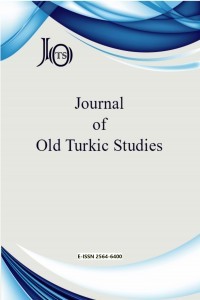
Journal of Old Turkic Studies
Yazarlar: ["Mehmet HAZAR"]
Konular:-
DOI:10.35236/jots.1213972
Anahtar Kelimeler:Altaic,Dolgan,Hungarian,Consonant splitting,Sigmatism,Stirrup (= üzengi)
Özet: The development of this consonant l > ş and r > z has been sufficiently studied in sound equivalence studies, but *l1 < *l/# > l2 > r2 consonant splitting has not been given much attention. The development of this consonant l > ş and r > z has been sufficiently studied in sound equivalence studies, but *l1 < *l/# > l2 > r2 consonant splitting has not been given much attention. This sound splitting ø < s < ş (< j ) < ç < l1 < *l > l2 > r > z > s > ø shaped development that can be called “L Cycle” will bring the issue of LIR and SAZ back to the agenda of Turcology. The three most difficult to study number names are a characteristic example: Manç. (j)il+an “3”, Moğ. guraw “three” ~ Moğ. kur+ban ‘hree’ < AA *ĝīl2+am > Çuv. weç(im) ‘three’ ~ vişşe, TT øüçø, *gul2am > *øulçam > *øøçam > Kor. san -not set- and Tuv. üj+en, Şor. üj+on ‘3 x 10’ -with diphthong- Kor. seol+eun ‘3 x 10’ -, Jap. san 三; -labial acration with instrumental- Hak. üz(öl+en) ‘three together’ -when the plural suffix loses its function, the suffix begins to accumulate-, Başk. ös, Karaçay-Balkar üč юч, Özb. uch, Tat. öç < üç, Kzk. üş ve Mac. hár+om ‘three’. As a result, the Altaic language theory is no longer a theory but a reality.